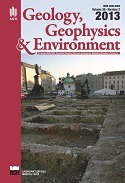Analysis of cross-sectional layers of corrosion using metallographic microscope
DOI:
https://doi.org/10.7494/geol.2013.39.2.125Keywords:
corrosion, enamel on copperplate, glass-metal, corrosion build-up, metallographic microscope, cross section of corrosion productsAbstract
The aim of this study was to identify and recognize the phenomena of corrosion between glass-metal connections. Experiments were carried out on historical and contemporary samples treated with corrosion catalysts and the results helped to identify the most corrosive conditions for historic objects. Microscopic observations were carried out on cross-sectional layers of specially prepared samples of enamel on copperplate, corresponding to the chemical composition of historic samples-enamel from Limoges. Subsequently, a series of techniques were implemented improving the quality of the image. A 20-micron thick corrosion layer can be observed and recorded using this method. Observations allowed to determine the quality and technology aspects of the enamel exposed to the processes. The diagnosis of corrosion processes is extremely important in order to determine the application technique of enamel on the metal substrate.
Microscopic images therefore revealed the formation of corrosion products. This proved an efficient and effective way to provide information on the thickness, color and structure of the observed layers. Micro-photographs from a metallographic microscope allowed for further planning and the subsequent use of a Scanning Electron Microscope (SEM) with an Energy Dispersive Spectrometer (EDS) and Raman Spectrometer (RS) - mitigating the need for the analysis of the entire sample's surface. Most corroded places have been identified and the metal proved to be more reactive material. The impact of factors such as: the technique of layering the enamel, structural inclusions, pitting corrosion, temperature and the environment's impact have been clearly linked to the overlap of the corrosion processes.
Downloads
References
Adriaens A. & Dowsett M.G., 2004. Electron microscopy and its role in cultural heritage studies. Comprehensive Analytical Chemistry, 42, 73-128.
Bonne D.G., Biron I. & Trocellier P., 1998. The origin of the degradation of painted enamels. Interim Meeting of the ICOM-CC Working Group, Vantaa 13-16 September 1998, Vantaa.
Drayman-Weisser T., 2003. Enamels of Limoges in the waiters art museum: historical context and observations on past treatments. Journal of the American Institute for Conservation, 42, 2,279-312.
Ekserdjian D., 2002. Analysis of Limoge Enamels from Wernher Collection at Rangers House. Apollo Magazine, annual edition, 8-14.
Fulforda M., Sim D., Doig A. & Painterb J., 2005. In defence of Rome: a metallographic investigation of Roman ferrous armour from Northern Britain. Journal of Archaeological Science, 32, 2, 241—250.
Greiner-Wronowa E., Thickett D. & Rajchel B., 2012. Study of enamel degradation on copper relief. 4th Biennial experts' meeting on Enamel on metal conservation, Abstract, Barcelona 14th -15th June 2012, Museu d'Historia de Catalunya, Barcelona.
Greiner-Wronowa E., 2011. Influence of Organic Pollutants on Deterioration of Antique Glass Structure. Acta Physica Polonica, 120, 4, 830-811.
Greiner-Wronowa E., 2005. Metoda sensorów szklanych w analizie przemian chemicznych korozji szkła. Świat Szkła, 5, 64-67.
Greiner-Wronowa E., 2010. Sensory szklane - metoda wczesnego monitorowania mikroklimatu w muzeum. Szkło i Ceramika, 3, 12-17.
Northover P., 2008. Encyclopedia of Archaeology. Elsevier, Amsterdam.
Pinasco M. R., Ienco M.G., Piccardo P., Pellati G. & Stagno E., 2007. Metallographic approach to the investigation of metallic archaeological objects. Annali di Chimica, 97, 7, 553-574.
Robinet L., Coupry C., Eremin K. & Hall C., 2006. Raman investigation of the structural changes during alteration of historic glasses by organic pollutants. Journal of Raman Spectroscopy, 37, 1278-1286.
Scott D.A., 2002. Copper and Bronze in Art: Corrosion, Colorants, and Conservation. Getty Publications, Los Angeles.
Siwulski S. & Nocuń M., 2008. Korozyjna degradacja powłok szklistych. Ceramika, 103, 2, 1357-1364.
Speel E. & Bronk H., 2001. Enamel painting: Materials and Recipes in Europe from c. 1500 to c.l920. Berliner Beitrage zur Archdometrie, 18, 43-100.
Downloads
Published
Issue
Section
License
Authors have full copyright and property rights to their work. Their copyrights to store the work, duplicate it in printing (as well as in the form of a digital CD recording), to make it available in the digital form, on the Internet and putting into circulation multiplied copies of the work worldwide are unlimited.
The content of the journal is freely available according to the Creative Commons License Attribution 4.0 International (CC BY 4.0)










